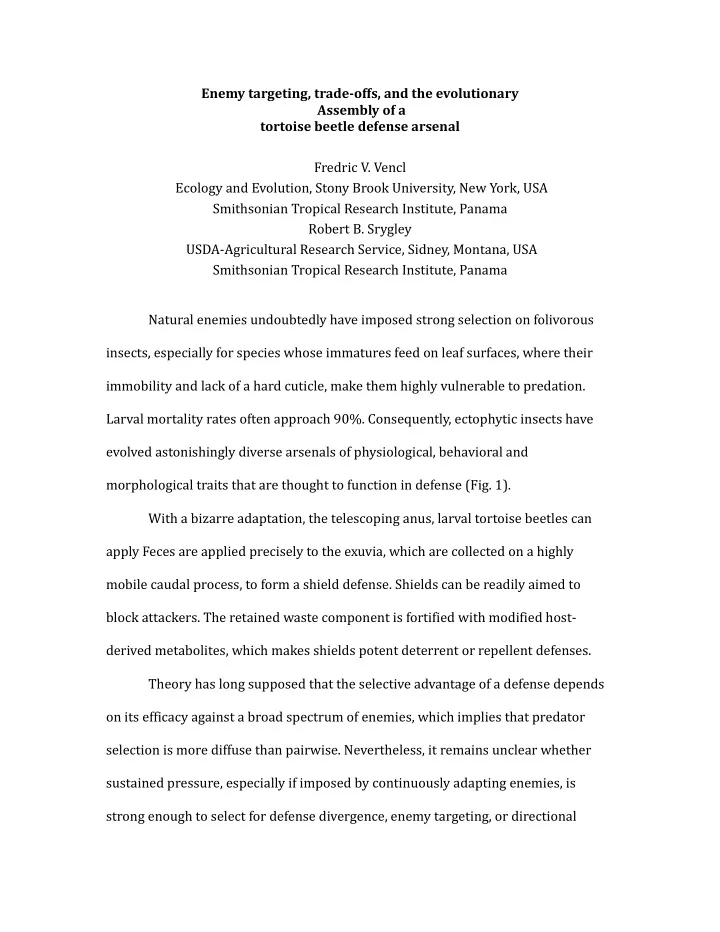

Enemy ¡targeting, ¡trade -‑ offs, ¡and ¡the ¡evolutionary ¡ ¡ Assembly ¡ of ¡a ¡ ¡ tortoise ¡beetle ¡defense ¡arsenal ¡ ¡ Fredric ¡V. ¡Vencl ¡ ¡ Ecology ¡and ¡Evolution, ¡Stony ¡Brook ¡University, ¡New ¡York, ¡USA ¡ Smithsonian ¡Tropical ¡Research ¡Institute, ¡Panama ¡ ¡ Robert ¡B. ¡Srygley ¡ ¡ USDA -‑ Agric ultural ¡Research ¡Service, ¡Sidney, ¡Montana, ¡USA ¡ Smithsonian ¡Tropical ¡Research ¡Institute, ¡Panama ¡ ¡ ¡ ¡ ¡ Natural ¡enemies ¡undoubtedly ¡have ¡imposed ¡strong ¡selection ¡on ¡folivorous ¡ insects, ¡especially ¡for ¡species ¡whose ¡immatures ¡feed ¡on ¡leaf ¡surfaces, ¡where ¡ their ¡ im mobility ¡and ¡lack ¡of ¡a ¡hard ¡ cuticle , ¡make ¡them ¡highly ¡vulnerable ¡to ¡predation. ¡ Larval ¡ mortality ¡rates ¡often ¡approach ¡90%. ¡Consequently, ¡ectophytic ¡insects ¡have ¡ evolved ¡astonishingly ¡diverse ¡arsenals ¡of ¡physiological, ¡behavioral ¡and ¡ morphological ¡traits ¡tha t ¡are ¡thought ¡to ¡function ¡in ¡defense ¡ (Fig. ¡1) . ¡ ¡ ¡ With ¡a ¡ bizarre ¡ adaptation, ¡the ¡ telescoping ¡anus , ¡ larval ¡ tortoise ¡beetle s ¡can ¡ apply ¡ Feces ¡are ¡applied ¡precisely ¡to ¡the ¡exuvia, ¡which ¡are ¡collected ¡on ¡a ¡highly ¡ mobile ¡caudal ¡process, ¡ to ¡form ¡a ¡ shield ¡defense . ¡ Shields ¡can ¡be ¡readily ¡aimed ¡to ¡ block ¡attackers. ¡The ¡retained ¡waste ¡component ¡is ¡fortified ¡with ¡modified ¡host -‑ derived ¡metabolites, ¡which ¡makes ¡shields ¡potent ¡deterrent ¡or ¡repellent ¡defenses . ¡ ¡ Theory ¡has ¡long ¡supposed ¡that ¡the ¡selective ¡advantage ¡of ¡a ¡defen se ¡depends ¡ on ¡its ¡efficacy ¡against ¡a ¡broad ¡spectrum ¡of ¡enemies, ¡which ¡implies ¡that ¡predator ¡ selection ¡ is ¡more ¡diffuse ¡than ¡pairwise. ¡ Nevertheless, ¡it ¡remains ¡unclear ¡whether ¡ sustained ¡pressure, ¡especially ¡if ¡imposed ¡by ¡continuously ¡adapting ¡enemies, ¡is ¡ str ong ¡enough ¡to ¡select ¡for ¡defense ¡divergence, ¡enemy ¡targeting, ¡or ¡directional ¡
trends ¡in ¡defense ¡efficacy ¡ (Vencl ¡& ¡Srygley ¡2013) . ¡ We ¡used ¡the ¡multi-‑trait ¡defense ¡ arsenal ¡of ¡the ¡tortoise ¡beetle, ¡Acromis ¡sparsa, ¡ to ¡ assessed ¡whether: ¡(1) ¡traits ¡were ¡ narrowly ¡ta rgeted, ¡lacking ¡strong ¡cross -‑ resistance ¡among ¡enemies; ¡(2) ¡a ¡trait, ¡or ¡its ¡ interactions, ¡increased ¡survival ¡against ¡one ¡enemy ¡at ¡the ¡expense ¡of ¡decreased ¡ survival ¡against ¡other ¡enemies, ¡and; ¡(3) ¡phylogenetically ¡newer ¡traits ¡out -‑ performed ¡ older ¡ones. ¡ and; ¡(4) ¡selection ¡by ¡different ¡enemies ¡resulted ¡in ¡positive ¡(escalation) ¡ trends ¡in ¡defense ¡effectiveness ¡in ¡the ¡ Acromis ¡lineage. ¡ ¡ Adults ¡and ¡larvae ¡of ¡ A. ¡sparsa ¡ ¡ feed ¡exclusively ¡on ¡the ¡morning ¡glory ¡vine, ¡ Merremia ¡umbellata ¡ (Convolvulaceae), ¡which ¡is ¡a ¡common ¡ colonist ¡of ¡forest ¡edges, ¡ gaps, ¡and ¡roadsides ¡throughout ¡Mesoamerica ¡ (Fig. ¡2 a ) . ¡ The ¡ defense ¡ arsenal ¡of ¡ A. ¡ sparsa ¡ consists ¡of ¡three ¡components: ¡ larval ¡shields , ¡gregariousness , ¡and ¡maternal ¡ guarding ¡behavior ¡ (Fig ¡2 ). ¡ Because ¡each ¡of ¡its ¡constituent ¡defenses ¡ can ¡be ¡modified ¡ or ¡ablated, ¡without ¡otherwise ¡harming ¡individuals, ¡the ¡ A. ¡sparsa ¡ defense ¡arsenal ¡ represents ¡an ¡ideal ¡model ¡system ¡to ¡examine ¡how ¡defenses ¡perform ¡in ¡isolation ¡or ¡ as ¡ensembles. ¡ ¡ ¡ A ¡recent ¡morpho -‑ molecular ¡phylogenetic ¡study, ¡which ¡combined ¡ larval ¡ performance ¡bioassays ¡using ¡a ¡ubiquitous ¡ant ¡predator , ¡ with ¡character ¡ reconstructions ¡of ¡defensive ¡traits, ¡proposed ¡that ¡larval ¡defenses ¡accumulated ¡ sequentially ¡after ¡larvae ¡ventured ¡into ¡the ¡leaf ¡surface ¡adaptive ¡zone ¡ (Fig. ¡3) . ¡The ¡ first ¡larval ¡de fense ¡was ¡initially ¡a ¡simple ¡barrier, ¡which ¡eventually ¡incorporated ¡host ¡ metabolites ¡to ¡form ¡a ¡mobile, ¡chemically ¡fortified ¡shield. ¡ Behind ¡the ¡chemical ¡shield, ¡ the ¡tortoise ¡beetles ¡may ¡have ¡ radiated ¡and ¡become ¡structurally ¡diverse -‑ over ¡ half ¡the ¡ species ¡in ¡ the ¡ subfamily ¡ reside ¡in ¡the ¡more ¡recent ¡tortoise ¡beetle ¡clades . ¡ Chemically ¡
enhanced ¡shields ¡were ¡followed ¡by ¡larval ¡gregariousness, ¡and ¡ultimately, ¡by ¡ maternal ¡ guarding ¡ (Fig. ¡3) . ¡ ¡ ¡ The ¡idea ¡that ¡ A. ¡sparsa's ¡ defense ¡arsenal ¡was ¡assembled ¡by ¡its ¡various ¡ ance stors ¡through ¡an ¡incremental ¡process ¡of ¡increasing ¡trait ¡potency ¡and ¡ complexity, ¡perhaps ¡as ¡a ¡response ¡to ¡the ¡impact ¡of ¡other ¡important ¡enemies , ¡ in ¡ addition ¡to ¡ ants, ¡ remains ¡unexplored. ¡ Whether ¡a ¡defense ¡is ¡narrowly ¡or ¡broadly ¡ targeted ¡can ¡best ¡be ¡determin ed ¡by ¡its ¡ablation ¡and ¡then ¡ by ¡ quantifying ¡the ¡ resulting ¡natural ¡selection ¡in ¡the ¡presence ¡of ¡an ¡array ¡of ¡enemies. ¡Given ¡that ¡shields, ¡ group ¡size , ¡ and ¡maternal ¡guarding ¡are ¡physically ¡independent, ¡we ¡were ¡able ¡to ¡ manipulate ¡each ¡trait, ¡or ¡combination ¡of ¡tr aits, ¡by ¡procedures ¡that ¡did ¡not ¡otherwise ¡ alter ¡ the ¡ larvae. ¡ ¡ ¡ We ¡used ¡a ¡combination ¡of ¡barrier, ¡exclusion , ¡ and ¡defensive ¡trait ¡ manipulations ¡to ¡quantify ¡the ¡efficacy ¡of ¡defensive ¡traits ¡and ¡their ¡interactions ¡ (Fig. ¡ 4) . ¡ These ¡experiments ¡were ¡designed ¡to ¡r ender ¡larvae ¡either ¡more ¡or ¡less ¡vulnerable ¡ to ¡different ¡enemies, ¡and ¡the ¡survival ¡of ¡individuals ¡was ¡quantified ¡in ¡a ¡four -‑ year ¡ field ¡study. ¡ The ¡study ¡site ¡consisted ¡ of ¡a ¡large ¡field ¡along ¡Pipeline ¡Road, ¡near ¡ Gamboa, ¡Panama ¡́, ¡which ¡consisted ¡ of ¡low ¡shrubs, ¡tree ¡saplings ¡and ¡grass , ¡ through ¡ which ¡a ¡network ¡of ¡access ¡trails ¡had ¡been ¡cut ¡ (Fig. ¡2a) . ¡ During ¡the ¡early ¡wet ¡season s ¡ (April -‑ July) ¡of ¡2007 – 2010, ¡females ¡of ¡ A. ¡spar sa ¡ guarding ¡egg ¡masses ¡were ¡located, ¡ flagged ¡and ¡monitored . ¡ ¡ ¡ ¡ In ¡addition ¡to ¡ants, ¡predatory ¡wasps, ¡bugs , ¡ and ¡parasitoid ¡flies ¡and ¡wasps ¡are ¡ important ¡enemy ¡guilds ¡ (Fig. ¡4) . ¡Today, ¡ we ¡ only ¡have ¡time ¡to ¡report ¡on ¡t he ¡impact ¡of ¡ predators ¡on ¡larvae ¡and ¡the ¡e fficacy ¡of ¡larval ¡defenses ¡ against ¡them . ¡
Recommend
More recommend